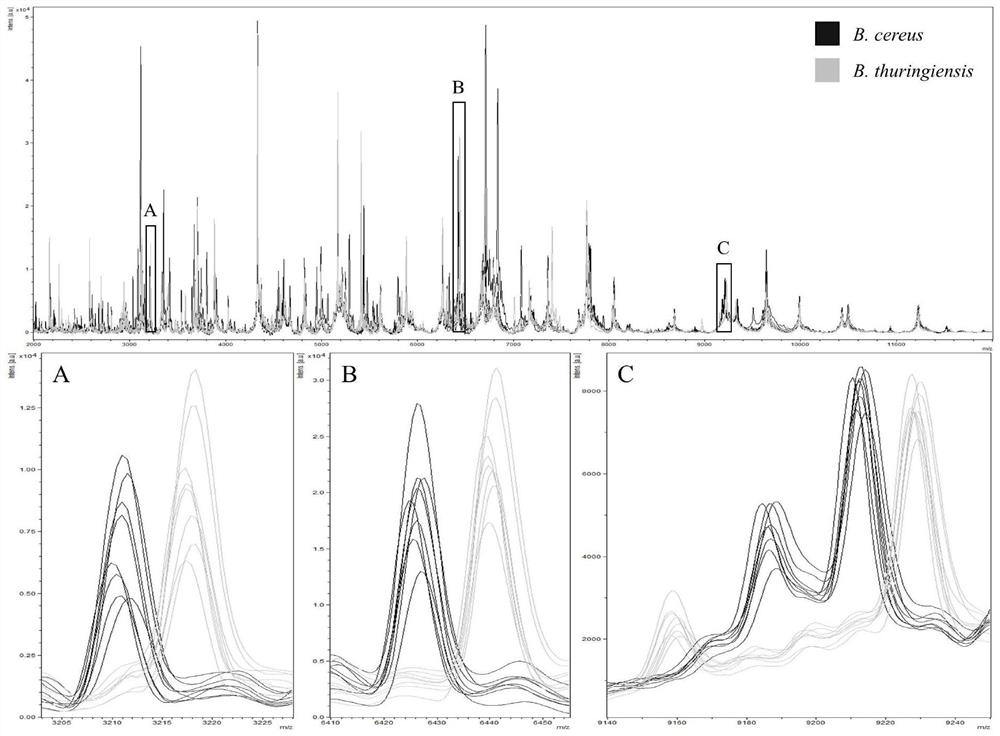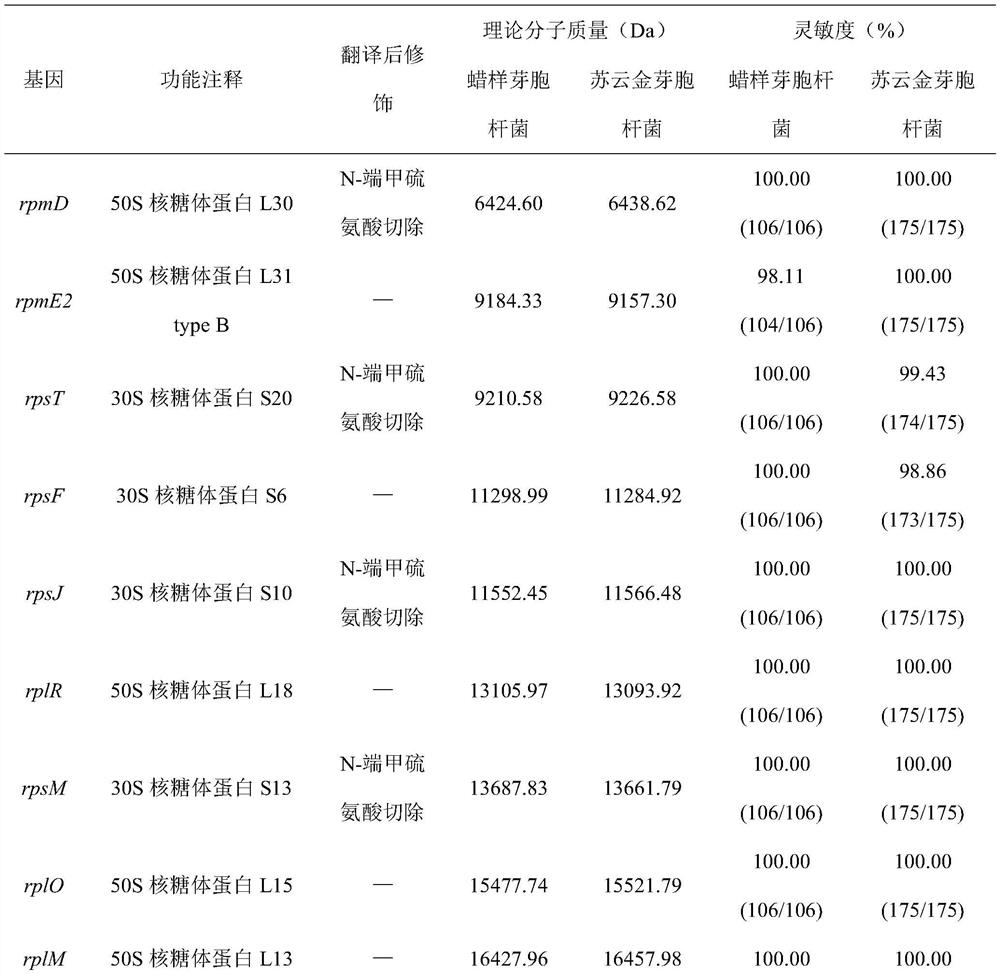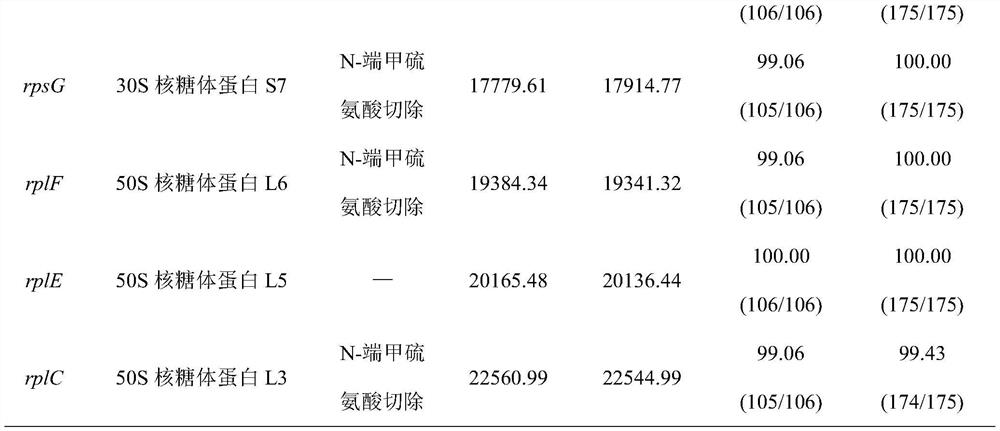Method for rapidly identifying bacillus cereus and bacillus thuringiensis based on MALDI-TOFMS
A technology of Bacillus thuringiensis and Bacillus cereus, applied in the field of microbial detection, can solve the problems of low resolution, inability to distinguish between Bacillus cereus and Bacillus thuringiensis, etc., achieve accurate and reliable results, reduce labor and consumables costs, Simple operation effect
- Summary
- Abstract
- Description
- Claims
- Application Information
AI Technical Summary
Problems solved by technology
Method used
Image
Examples
Embodiment 1
[0019] Example 1: Mining potential MALDI-TOFMS characteristic peaks of Bacillus cereus and Bacillus thuringiensis based on genome-wide data
[0020] Search GTDB (https: / / gtdb.ecogenomic.org / ), rMLST (https: / / pubmlst.org / rmlst) and NCBI (https: / / www.ncbi.nlm.nih.gov / genome / ) three databases Among the taxonomic information of Bacillus cereus and Bacillus thuringiensis, 106 strains of Bacillus cereus and 175 strains of Bacillus thuringiensis had consistent species information in the three databases. After downloading the whole genome sequence of the strain, use Prokka to annotate the whole gene sequence, and use TBtools to extract the ribosomal protein sequence. Analyzes ribosomes by considering N-terminal methionine cleavage when the second amino acid at the N-terminus of the amino acid chain is glycine, alanine, proline, serine, threonine, valine, or cysteine For protein N-terminal methionine removal, use the protein molecular mass calculator (https: / / web.expasy.org / compute_pi...
Embodiment 2
[0024] Example 2 Screening and identification of MALDI-TOF MS characteristic peaks of Bacillus cereus and Bacillus thuringiensis
[0025]35 strains of Bacillus cereus, 44 strains of Bacillus thuringiensis and their corresponding ATCC standard strains were selected for experiments. The strains were streaked on LB agar and cultured at 37°C for 16 hours. Use a sterile toothpick to directly smear the colony on the target plate, add 1 μL of 70% formic acid aqueous solution by volume fraction, wait for it to dry, add 1 μL of standard solution containing 10 mg / mL α-cyano-4-hydroxycinnamic acid (by volume fraction, Consisting of 50% acetonitrile, 47.5% water and 2.5% trifluoroacetic acid), dried for detection. MALDI-TOF MS detection uses a 200Hz smartbeam solid-state laser to collect spectra in the range of 2-20kDa in positive ion linear mode. Each sample is bombarded 240 times by laser, and BTS (bacterial test standard) is used for calibration before each experiment. The collected m...
Embodiment 3
[0029] Example 3 Specificity Evaluation Results of MALDI-TOF MS Characteristic Peaks of Bacillus cereus and Bacillus thuringiensis
[0030] According to the national and international standards of common foodborne pathogenic bacteria in food microbiological examination, 13 strains of common foodborne pathogenic bacteria were selected for the specificity test of MALDI-TOF MS characteristic peaks of Bacillus cereus and Bacillus thuringiensis. The strain obtained the MALDI-TOF MS spectrum through the cultivation and sample preparation steps in Example 2, and the specificity results are shown in Table 3. The MALDI-TOF MS characteristic peaks of Bacillus cereus and Bacillus thuringiensis in the present invention do not overlap with the mass spectrum peaks of common food-borne pathogenic bacteria, so they are specific to Bacillus cereus and Bacillus thuringiensis. The characteristic peak of the present invention can be used as a specific MALDI-TOF MS peak for distinguishing Bacillus...
PUM
 Login to View More
Login to View More Abstract
Description
Claims
Application Information
 Login to View More
Login to View More - R&D
- Intellectual Property
- Life Sciences
- Materials
- Tech Scout
- Unparalleled Data Quality
- Higher Quality Content
- 60% Fewer Hallucinations
Browse by: Latest US Patents, China's latest patents, Technical Efficacy Thesaurus, Application Domain, Technology Topic, Popular Technical Reports.
© 2025 PatSnap. All rights reserved.Legal|Privacy policy|Modern Slavery Act Transparency Statement|Sitemap|About US| Contact US: help@patsnap.com



